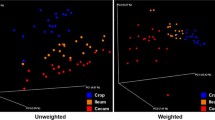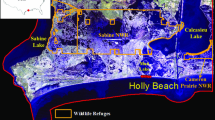Abstract
Microflora population of poultry was affected by various factors. Many methods and techniques were developed to study microflora population. But, most of them confronted some problems. Moreover, being costly, laborious, and time-consuming made it impossible to measure microflora population several times. In this study, we tried to estimate intestinal microflora population using artificial neural network (ANN). Lactic acid bacteria were used as model of microflora population. Time and lactic acid bacteria were used as input and output variables, respectively. The best model of ANN was determined based on coefficient of determination, root mean square error, and mean absolute error criteria. The results of current study have shown that ANN is appropriate, cheap, and reliable tools to estimate intestinal microflora population (lactic acid bacteria) of broiler at different ages.


Similar content being viewed by others
References
Abdolmaleki P, Naderimanesh H, Falah Farbord SK, Taghdir M, Sadeghi M (2001) Predict of protein structure by use of artificial neural network. 10th international biologic conference Iran. Shiraz University, 91212 (In Persian)
Apajalahti JHA, Kettuneen A, Holben WE, Nurminrn PH, Rautonen N, Mutanen M (2002) Culture-independent microbial community analysis reveals that inuline in the diet primarily affects previously unknown bacteria in the mouse ceacum. Appl Environ Microbiol 68:4986–4995
Apajalahti JHA, Kettuneen A, Bedford MR, Holben WE (2001) Percent G + C profiling accurately reveals diet-related differences in the gastrointestinal microbial community of broiler chickens. Appl Environ Microbiolo 67:5656–5667
Barrow PA (1992) Probiotics for chicken. In: Fuller R (ed) Probiotics: the scientific basis. Chapman and Hall, London, pp 229–234
Chaveerch P, Keuzenkamp DA, Lipman LJA, Van Knapen F (2004) Effect of organic acids in drinking water for young broilers on campylobacter infection, volatile fatty acid production, gut microflora and histological cell changes. Poult Sci 83:330–334
Cigizoglu HK, Kisi O (2005) Flow prediction by two back propagation techniques using k-fold partitioning of neural network training data. Nord Hydrol 36(1):1–16
Engberg RM, Hedmann MS, Steenfeldt S, Jensen B (2004) Influence of whole wheat and xylanase on broiler performance and microbial composition and activity in the digestive tract. Poult Sci 83:925–938
Engberg RM, Hedmann MS, Jensen B (2002) The influence of grinding and pelleting of feed on the microbial composition and activity in the digestive tract of broiler chickens. Br Poultr Sci 43:569–579
Escalante-Minakata P, Ibarra-Junquera V, Rosu HC, De Leon-Rodriguez A, Gonzalez-Garcia R (2009) Online monitoring of Mezcal fermentation based on redox potential measurements. Bioprocess Biosyst Eng 32:47–52
Govindaraju RS, Ramachander Rao A (eds) (2000) Water science and technology library. Artificial neural networks in hydrology. Kluwer Academic Publishers, Dordrecht, The Netherlands
Hubener K, Vahjen W, Simon O (2002) Bacterial responses to different dietary cereal types and xylanase supplementation in the intestine of broiler chicken. Arch Anim Nutr 56:167–187
Imrie CE, Durucan S, Korre A (2000) River flow prediction using artificial neural networks: generalization beyond the calibration range. J Hydrol 233:138–153
Jain A, Srintvasulu S (2004) Development of effective and efficient rainfall–runoff models using integration of deterministic, real-coded genetic algorithms, and artificial neural network techniques. Water Resour Res 40(4): W04302. doi:10.1029/2003WR002355
Jin LZ, Marquardt RR, Zhoa X (2000) A strain of enterococcus faecium (18C23) inhibits adhesion of enterotoxigenic escherichia coli K88 to porcine small intestine mucus. Appl Environ Microbiol 66:4200–4204
Keskin ME, Terzi O (2006) Artificial neural networks models of daily pan evaporation. J Hydrol Eng ASCE 11(1):65–70
Kim S, Kim HS (2008) Neural networks and genetic algorithm approach for nonlinear evaporation and evapotranspiration modeling. J Hydrol 351:299–317
Kisi O, Yildirim G (2005) Discussion of ‘Estimating Actual Evapotranspiration from Limited Climatic Data Using Neural Computing Technique’ by K.P. Sudheer; A.K. Gosain; and K.S. Ramasastri. ASCE J Irrigation Drainage Eng 131(2):219–220
Knarreborg A, Engberg RM, Jensen SK, Jensen BB (2002) Quantitative determination of bile salt hydrolase activity in bacteria isolated from the small intestine of chickens. Appl Environ Microbiol 68:1120–1124
Knarreborg A, Simon MA, Engberg RM, Jensen BB, Tannock GW (2002) Effects of dietary fat source and subtherapeutic levels of antibiotic on the bacterial community in the ileum of broiler chickens at various ages. Appl Environ Microbiol 68:5918–5924
Lan Y, Xun S, Tamminga S, Williams BA, Verstegem MWA, Erdi G (2004) Real-time PCR detection of lactic acid bacteria in cecal contents of Eimeria tenella-infected broilers fed soybean oligosaccharides and soluble soybean polysaccharides. Poult Sci 83:1696–1702
Landeras G, Ootiz-Barredo A, Lopez JJ (2008) Comparison of artificial neural network models and empirical and semi-empirical equations for daily reference evapotranspiration estimation in the Basque Country (Northern Spain). Agric Water Manag 95:553–565
Lu J, Idris U, Harmon B, Hofacre C, Maurer JJ, Lee MD (2003) Diversity and succession of the intestinal bacterial community of the maturing broiler chicken. Appl Environ Microbiol 69:6816–6824
Mathlouthi N, Mallet S, Saulnier L, Quemener B, Larbier M (2002) Effects of xylanase and -glucanase addition on performance, nutrient digestibility, and physico-chemical conditions in the small intestine contents and caecal microflora of broiler chickens fed a wheat and barley-based diet. J Anim Sci 51:395–406
Mead GC (2000) Prospects for ‘competitive exclusion’ treatment to control salmonellas and other foodborne pathogens in poultry. Vet J 159:111–123
Ochi Y, Mitsuoka T, Sega T (1964) Nature Untersuchungen uber die Darmflora des Huhn III Mitteilung: die Entwicklung der Darmflora von Kuken bis zum Huhn. Zentralbl Bakteriol Parasitenkd Infektionskr Hyg Abt 1 Orig 193:80–95
Patterson JA, Burkholder KM (2003) Application of prebiotics and probiotics in poultry production. Poult Sci 82:627–631
Riad S, Mania G, Bouchaou L, Najjar Y (2004) Rainfall-runoff model using an artificial neural network approach. Math Comput Model 40:839–846
Smirnov A, Perez R, Amit-Romach E, Skllan D, Uni Z (2005) Mucin dynamics and microbial populations in chicken small intestine are changed by dietary probiotic and antibiotic growth promoter supplementation. J Nutr 135:187–192
Torok VA, Ophel-Keller K, Hughes RJ (2005) The development of molecular tools for monitoring gut microflora of poultry. Aust Poult Sci Symp 17:93–95
Van Der Wielen PW, Keuzenkamp DA, Lipman LJ, Van Knapen F, Biesterveld S (2002) Spatial and temporal variation of the intestinal bacterial community in commercially raised broiler chickens during growth. Microb Ecol 44:286–293
Van Leeuwen P, Mouwen JM, Van Der Klis JD, Verstegen MW (2004) Morphology of the small intestinal mucosal surface of broilers in relation to age, diet formulation, small intestinal microflora and performance. Br Poult Sci 45:41–48
Vidabarachi JK, Mikkelsen LL, Sims IM, Iji PA, Choct M (2006) Selected plant extracts modulate the gut microflora in broilers. Aust Poult Sci Symp 18:145–148
Williams BA, Verstegen MWA, Tamminga S (2001) Fermentation in the large intestine of single-stomached animals and its relationship to animal health. Nutr Res Rev 14:207–227
Zoetendal EG, Akkeremans ADL, De Vos WM (1998) Temperature gradient gel electrophoresis analysis of 16S rRNA from human fecal samples reveals stable and host-specific communities of active bacteria. Appl Environ Microbiol 64:3854–3859
Acknowledgments
Our special thanks of Bu-Ali Sina University for providing facilities and financial support of this study. We also wish to thank to the staff of the Department of Animal Science of this university for their excellent scientific collaboration.
Author information
Authors and Affiliations
Corresponding author
Rights and permissions
About this article
Cite this article
Hemati Matin, H.R., Saki, A.A., Aliarabi, H. et al. Intestinal broiler microflora estimation by artificial neural network. Neural Comput & Applic 21, 1043–1047 (2012). https://doi.org/10.1007/s00521-011-0553-2
Received:
Accepted:
Published:
Issue Date:
DOI: https://doi.org/10.1007/s00521-011-0553-2




